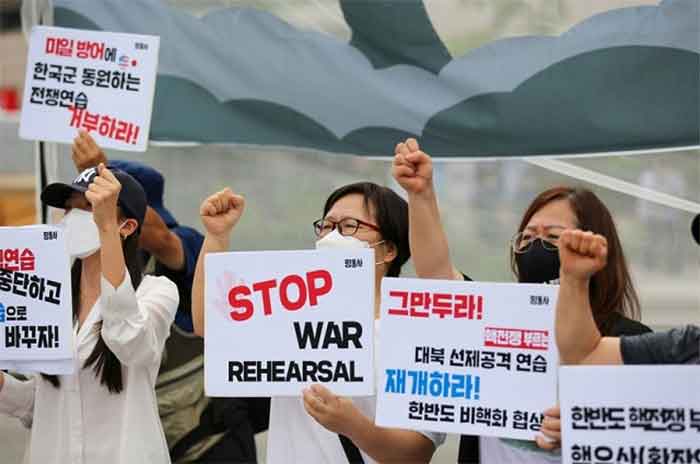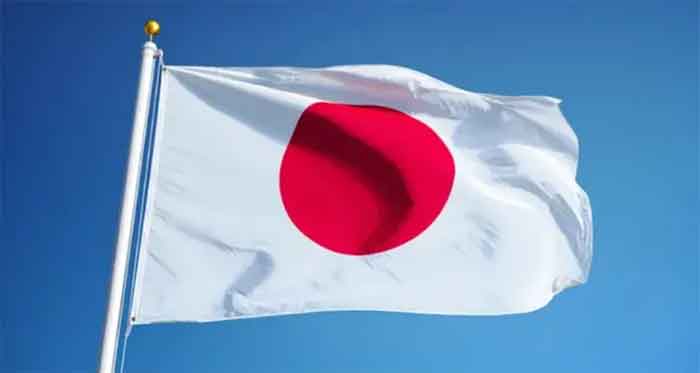
While readers need no introduction to Hermann Göring, head of the Nazi Luftwaffe and Hitler’s onetime designated successor, Göring’s explanation of how to convince the people of a nation to go to war may not be as familiar. During his trial for war crimes at Nuremburg in 1946 Göring said:
“Naturally the common people don’t want war: Neither in Russia, nor in England, nor for that matter in Germany. That is understood. But, after all, it is the leaders of the country who determine the policy and it is always a simple matter to drag the people along, whether it is a democracy, or a fascist dictatorship, or a parliament, or a communist dictatorship. Voice or no voice, the people can always be brought to the bidding of the leaders. That is easy. All you have to do is tell them they are being attacked and denounce the peacemakers for lack of patriotism and exposing the country to danger. It works the same in any country.”
In today’s Japan there are near daily television announcements, sometimes accompanied by air raid sirens, of yet another North Korean missile test, or of Chinese ships sailing close to the Japan-administered Senkaku Islands in the East China Sea, or of joint Russian-China naval exercises in the Sea of Japan, etc. For its part, the government of Japan repeatedly states these activities, not to mention the war in Ukraine, demonstrate that Japan is in ever increasing danger of being attacked by one, two or even all three of these countries.
In response to this alleged danger, on 16 December 2022 Japan unveiled sweeping changes to its national security strategy including plans to double its military budget from 1 to 2% of GDP. Accordingly, Prime Minister Fumio Kishida instructed his defense and finance ministers to increase the country’s military spending by more than 50% over five years to around ¥43 trillion ($315 billion).
Just how sweeping this change is can be understood when compared with Article 9 of Japan’s current constitution: “The Japanese people forever renounce war as a sovereign right of the nation and the threat or use of force as means of settling international disputes. . . . land, sea, and air forces, as well as other war potential, will never be maintained.”
An additional major change is the move to acquire “counterstrike” capabilities, i.e., the ability to strike enemy bases with long-range missiles in coordination with the US. Japan aims to acquire a long-range strike capability using both Japan-made missiles as well as imported foreign ones, including purchases of US-built Tomahawk cruise missiles. The end result is that by 2027 Japan is projected to have the third largest military in the world even as, at least on paper, it remains under the constraints of Article 9 of the constitution.
If the gap between Japan’s peace constitution and its increasing military power seems strange, if not hypocritical, it is matched by another phenomenon, at least as far as North Korea is concerned. Namely, neither the Japanese government nor its mass media ever discuss why North Korea might attack Japan. Does North Korea simply want to kill as many Japanese as possible? Or occupy Japan with its nearly non-existent navy?
As a former intelligent analyst attached to headquarters of United States Forces Japan located at Yokota Air Force Base (AFB) outside of Tokyo, I am able to answer this question from personal experience. The US military knows full well that North Korean missiles are not aimed at the Japanese people but at those US military bases in Japan that would be used to attack North Korea in the event the Korean War, now in a state of armistice, not peace, were to recommence. First and foremost, North Korean missiles would be aimed at Yokota AFB since US military forces in Korea are under its command. Other important targets include the headquarters and ships of the US Seventh Fleet located at the US Naval Base in Yokosuka and Kadena AFB located in Okinawa.
Thus, the true reason for a buildup of Japanese military forces is to provide increased protection for US military bases in Japan rather than protect the Japanese people. Japan’s new commitment to directly strike North Korean missile bases is for the same purpose. These facts, however, are never told to the Japanese people who are, instead, repeatedly told that North Korea’s missiles pose a “palpable threat” to their safety. Moreover, it is a threat that can only be eliminated by a major increase in military expenditures, not by the removal of targeted US military bases from their country.
A similar story can be told in regard to the Senkaku islands (Ch. Diaoyutai). As today’s Japanese newspapers are quick to note, Japan first took control of the Senkakus in 1895. However, what is never mentioned are the circumstances of this takeover, namely that the Japanese Cabinet first secretly annexed the Senkakus on 14 January 1895, at a time when Japan was certain of winning the first Sino-Japanese War that had begun on 25 July 1894. Thus, far from being terra nullius (L., nobody’s land ) as Japan claimed then and now, the Senkakus were early senka (fruits of battle) of Imperial Japan. At the time, China, the historic but militarily weak owner of the Senkakus, could do nothing to prevent Japan’s takeover.
Today, Japan uses China’s naval incursions into waters near the Senkakus as proof of Chinese aggressiveness. This in turn is used to justify the Japanese military’s current buildup on the southernmost Okinawan island of Yonaguni, located 150 km (93 mi.) south of the Senkakus. At the same time this build-up serves a second purpose for both the Japanese and US militaries in that Yonaguni is located only 111 km (69 mi.) from Taiwan and therefore makes an ideal staging area to resupply and support the Taiwanese military should China elect to annex Japan’s former colony of Taiwan by force.
As for the four islands to the north of Japan, claimed by Japan but currently occupied by Russia, the situation is somewhat different. It is different in the sense that these four islands, as well as all of Siberia, have not historically been Euro-centric Russian territory. Instead, from the 16th thru the 19th centuries, Czarist Russian imperialism slowly conquered the native peoples of Siberia. However, it is equally important to recognize that these cold northern islands have likewise not been a historic part of rice-growing Japan either! For today’s Russia, control of these four islands ensures that neither Japan nor its military ally the US can block the Russian naval fleet, especially its submarines, from accessing the Pacific Ocean.
If one were to ask whom these islands historically belonged to, it would be the indigenous Ainu who occupied these and nearby islands up until the very end of the 19th century. Fearing a Russian takeover if they did not act first, the Meiji government began a policy of forced assimilation of the Ainu, including those living on the island of today’s Hokkaido. Hokkaido was originally known in Japanese as “Ezo-chi” (Ainu land), until it, too, was forcefully annexed and renamed Hokkaido in 1869. Russia’s annexation of the four islands following Japan’s defeat in WW II only marked the latest round in the clash between the competing imperialisms of the two countries. Neither country then, nor now, has ever consulted the Ainu as to their wishes.
At present, the only real debate within Japan concerning the proposed military buildup and new counterstrike capabilities is who will pay for the cost. Prime Minister Kishida claims that, at least initially, three-quarters of the funding will come by reallocating current expenditures to defense. The remainder is to come through taxes on a mix of corporate, tobacco and disaster-reconstruction income. On the one hand, surveys show a majority of voters want more spent on defense, yet the idea of a tax hike on the general population to fund the expansion is unpopular — especially at a time when Japan is experiencing its worst inflation in 40 years. A recent poll published by the conservative Sankei Shimbun and broadcaster FNN found that almost 70% of the population were opposed to a general tax increase for military spending.
Japan can thus be said to be in the midst of a classic “guns vs butter” dilemma. About this, US President Dwight D. Eisenhower, a former five-star Army general, said:
”Every gun that is made, every warship launched, every rocket fired signifies, in the final sense, a theft from those who hunger and are not fed, those who are cold and are not clothed. This world in arms is not spending money alone. It is spending the sweat of its laborers, the genius of its scientists, the hopes of its children . . . This is not a way of life at all in any sense. Under the cloud of threatening war, it is humanity hanging from a cross of iron.”
Eisenhower issued this warning on 16 April 1953. Today, some 70 years later, the question is has anything changed? The answer is all too little with the exception that, due to human-induced climate change, the “cloud of threatening war” has expanded to include severe droughts, record-breaking rainfall and snowfall, more powerful and frequent typhoons, rising sea levels, intense heatwaves, etc. Even the cross of iron may now, due to exponentially more powerful nuclear weapons, vaporize just that much faster in the event of a nuclear war (let alone the humanity who would be vaporized with it).
And yet Japan, together with nearly all “developed” countries in the world, devotes ever increasing amounts of its limited yearly budget to building ever bigger, ever more powerful, crosses of iron. One would like to believe that if the Japanese people ever learned the truth about Japan’s aggressive actions since the Meiji Restoration of 1868 they would not allow their country to once again become a major military power, this time assigned a key role in America’s plan to contain if not weaken China.
Needless to say, this role could lead to a massive loss of Japanese life in the event war were to occur.
One is left to hope that Göring was wrong about using fear as an effective method of rousing a population to go to war. That is to say, fear or no fear, one hopes the Japanese people will refuse to foot the bill for a massive military buildup effected at the cost of a significant decrease in their living standards including further cuts to the country’s already limited social spending.
Only time will tell.
Brian Victoria, Ph.D., Senior Research Fellow, Oxford Centre for Buddhist Studies













































